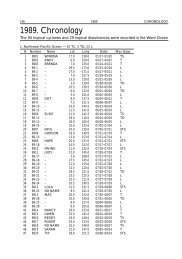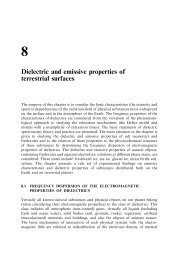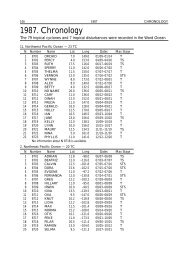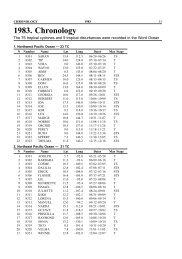Программа и тезисы докладов - Институт космических ...
Программа и тезисы докладов - Институт космических ...
Программа и тезисы докладов - Институт космических ...
Create successful ePaper yourself
Turn your PDF publications into a flip-book with our unique Google optimized e-Paper software.
The advanced analySiS oF Tle according To uv deTecTor oF MSu<br />
“TaTiana” Type MicroSaTelliTeS and iSr raS MicroSaTelliTe “chibiS-M”<br />
G. K. Garipov, P. A. Klimov, M. I. Panasyuk,<br />
S. I. Svertilov, B. A. Khrenov, I. V. Yashin<br />
Skobel’tsyn Institute of Nuclear Physics of Lomonosov Moscow State University, Russia<br />
The study of TLE geographical distribution along the trajectory of satellites<br />
shows that a large proportion of flashes is detected outside cloud formations and<br />
stretches along a meridian outside thundery formations over the continents. Distribution<br />
of flashes in the perpendicular direction ends abruptly at the continent<br />
border. Various hypotheses, which have been proposed to explain the experimental<br />
results, including the effect of the magnetic field of the Earth, are discussed in the<br />
report. The data of microsatellite «Tatiana-2», whose trajectory over South America<br />
coincides with the maximum gradient strength of the global magnetic field is examined<br />
and the preliminary results of microsatellite “Chibis-M”, along the path of<br />
which the magnetic field remains almost constant, are considered.<br />
The relaTiviSTic elecTron deTecTorS For The TaraniS projecT<br />
J.-A. Sauvaud, P. Devoto, A. Fedorov,<br />
G. Orttner, O. Chasselat<br />
IRAP, Toulouse, France<br />
The main goal of the two electron detectors IDEE onboard the sun-synchronous<br />
TARANIS spacecraft is the detection of Relativistic Runaway Electrons<br />
(RRE) associated with Terrestrial Gamma Flashes/sprites. The electrons are expected<br />
to come either directly from the low altitude atmosphere or more probably<br />
to be produced by gamma rays at higher altitudes. The IDEE spectrometers are designed<br />
to measure bursty fluxes of electrons in the energy range from 100 keV up to 4<br />
MeV. Two detection planes are associated, a silicon detector followed by a CdTe detector.<br />
Coincidence between the two detectors allows to obtain an estimation of the<br />
arrival direction of the electrons. The CdTe detector devoted to high energy measurements<br />
has a sufficient area, 64 cm 2 , to measure the expected fuxes. A secondary<br />
goal of IDEE is the study of lightning induced electron precipitation (LEP). Here<br />
the energy of the electrons is generally lower than 300 keV. These low energy electronswill<br />
be detected by the upper silicon detector, associated with a collimator to<br />
obtain information of the arrival direction. A final goal of IDEE is the study of the<br />
radiation belts with particular emphasis on wave-particle interaction/acceleration.<br />
The time resolution of the measurement is 0.1 second in survey mode and on the<br />
order of 10 microseconds in burst mode. The spectrometer is presented and its main<br />
properties discussed, including the ASIC electronics.<br />
31

















